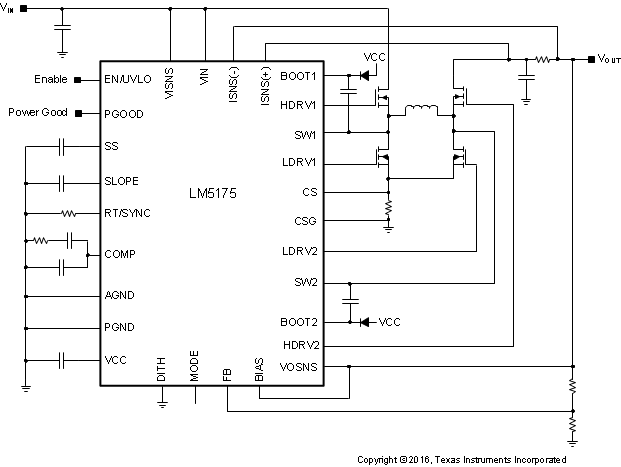ZHCSDH1A October 2015 – May 2016 LM5175
PRODUCTION DATA.
- 1 特性
- 2 应用
- 3 说明
- 4 简化电路原理图
- 5 修订历史记录
- 6 Pin Configuration and Functions
- 7 Specifications
-
8 Detailed Description
- 8.1 Overview
- 8.2 Functional Block Diagram
- 8.3
Feature Description
- 8.3.1 Fixed Frequency Valley/Peak Current Mode Control with Slope Compensation
- 8.3.2 VCC Regulator and Optional BIAS Input
- 8.3.3 Enable/UVLO
- 8.3.4 Soft-Start
- 8.3.5 Overcurrent Protection
- 8.3.6 Average Input/Output Current Limiting
- 8.3.7 CCM/DCM Operation
- 8.3.8 Frequency and Synchronization (RT/SYNC)
- 8.3.9 Frequency Dithering
- 8.3.10 Output Overvoltage Protection (OVP)
- 8.3.11 Power Good (PGOOD)
- 8.3.12 Gm Error Amplifier
- 8.3.13 Integrated Gate Drivers
- 8.3.14 Thermal Shutdown
- 8.4 Device Functional Modes
-
9 Application and Implementation
- 9.1 Application Information
- 9.2
Typical Application
- 9.2.1 Design Requirements
- 9.2.2
Detailed Design Procedure
- 9.2.2.1 Frequency
- 9.2.2.2 VOUT
- 9.2.2.3 Inductor Selection
- 9.2.2.4 Output Capacitor
- 9.2.2.5 Input Capacitor
- 9.2.2.6 Sense Resistor (RSENSE)
- 9.2.2.7 Slope Compensation
- 9.2.2.8 UVLO
- 9.2.2.9 Soft-Start Capacitor
- 9.2.2.10 Dither Capacitor
- 9.2.2.11 MOSFETs QH1 and QL1
- 9.2.2.12 MOSFETs QH2 and QL2
- 9.2.2.13 Frequency Compensation
- 9.2.3 Application Curves
- 10Power Supply Recommendations
- 11Layout
- 12器件和文档支持
- 13机械、封装和可订购信息
1 特性
2 应用
- 汽车起停系统
- 备用电池和超级电容充电
- 工业 PC 用电源
- USB 供电
- LED 照明
3 说明
LM5175 是一款同步四开关降压-升压 DC/DC 控制器,能够将输出电压稳定在输入电压、高于输入电压或者低于输入电压的某一电压值上。LM5175 具有 3.5V 至 42V 的宽输入电压范围(最大值为 60V),支持各类 应用。
LM5175 在降压和升压工作模式下均采用电流模式控制,以提供出色的负载和线路调节性能。开关频率可通过外部电阻进行编程,并且可与外部时钟信号同步。
该器件还 具有 可编程的软启动功能,并且提供 诸如 逐周期电流限制、输入欠压锁定 (UVLO)、输出过压保护 (OVP) 和热关断等各类保护特性。此外,LM5175 特有 可选择的连续导通模式 (CCM) 或断续导通模式 (DCM)、可选平均输入或输出电流限制、可降低峰值电磁干扰 (EMI) 的可选扩展频谱、以及应对持续过载情况的可选断续模式保护。
4 简化电路原理图
